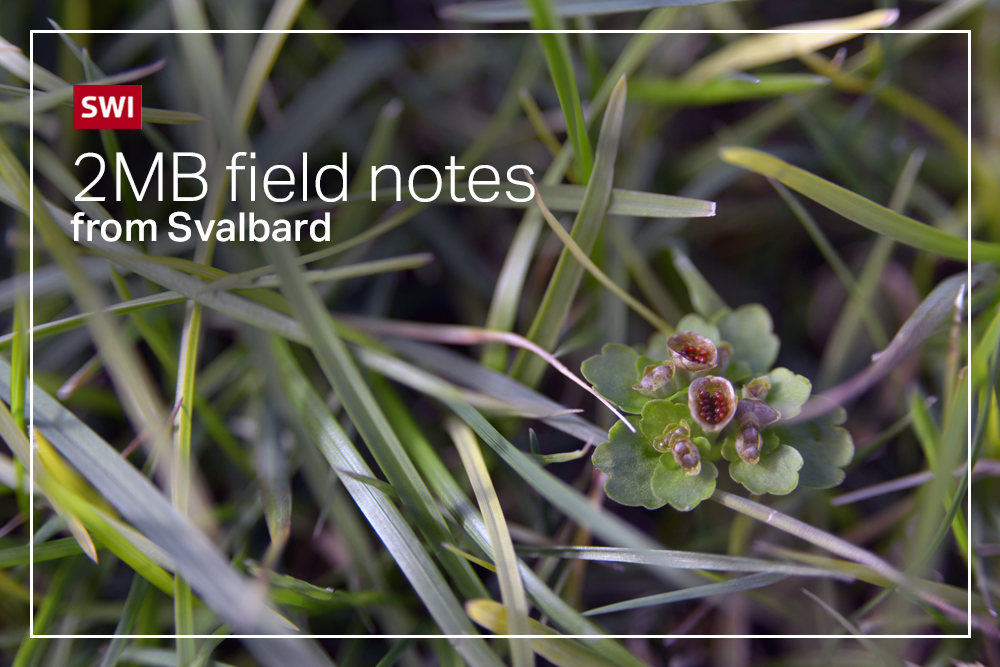The links between human settlements and the greening of the Arctic
The Barentsburg settlement in Svalbard is populated mainly by Russian and Ukrainian miners and their families. Many old wooden houses have fallen into disrepair here, but there are also newer apartment buildings made of precast concrete, as well as a lovely bar that serves excellent traditional Russian cuisine and European dishes.
This content was published on August 21, 2022 – 11:00
Lena Bakker, Sigrid Trier Kjaer and Jana Ruthers
All of today’s settlements in Svalbard originated from coal mining, which began in the early 20th century. Mining is still going on in some settlements. Roads and houses were built and people imported cattle, hay and even land to grow their own vegetables. This was a significant addition to their very limited supply of imported food and relieved some of the pressure on shipping from their home countries of Britain, Russia and Ukraine.
2MB field notes from Svalbard
End of insertion
These settlements, however, disrupted the pristine landscape of the islands, including the displacement and importation of soil, hay and livestock. Imported soil contains higher amounts of nutrients than native soil. As livestock dung and hay decomposed, the soil became increasingly nutritious, providing very different growing conditions for plants and microbiota.
In Longyearbyen, the northernmost permanent settlement in the world, we worked next to an old banished barn. We were able to directly observe a massive change of plant species, compared to the natural tundra, composed mainly of grasses. It was worth noting that the few species of tundra plants that we found on this site grew much larger than in the tundra. Our observations were also confirmed below ground: the soil has a very high organic content similar to peat. We had to dig deeper than expected to reach bedrock. Only a few sites have reached permafrost.
Our research site in Barentsburg was located under a dog park and was very lush and green. What we found there was simply amazing. Again, the vegetation is mostly grasses, but we even found a few non-native plant species that produced lots of flowers.
When we visit the site again at the end of August, we will know if they have produced seeds and are able to spread widely. So far we have found species that have never been identified on Svalbard before. Surprisingly, we have also observed some of these species in nearby undisturbed tundra, which means they are likely able to compete with native vegetation, with implications still unknown for the whole ecosystem. The soil was completely different, containing large amounts of old hay, sawdust and cattle droppings. This is why the soil is so rich in nutrients, especially nitrogen and phosphate, which facilitates the establishment of non-native species.
These places made us think a lot. What will happen to this amazing landscape if the disturbances increase? It is very likely that as the number of tourists increases, the number of introduced non-native species will increase. Tourists bring seeds via dirty shoes or other equipment, such as tents. With the increase in the number of tourists, tourism companies want to go to more and more remote places, so more and more places are at risk.
Another important aspect is the rise in temperatures due to global warming, which in turn facilitates the establishment and growth of native as well as non-native plants, possibly affecting their competitive patterns. It is likely that native plants will be overtaken to some degree. These locations of human disturbance and nutrient input have now proven to be potential stepping stones for non-native species to invade native tundra and special bird cliffs.
Scroll down to read previous entries from Lena, Sigrid, and Jana. To receive future editions of this blog in your inbox, subscribe to our scientific newsletter by entering your email address in the field below.

Complies with JTI standards
Find out more: SWI swissinfo.ch certified by the Journalism Trust Initiative









Comments are closed.